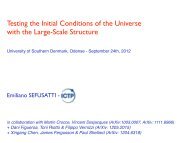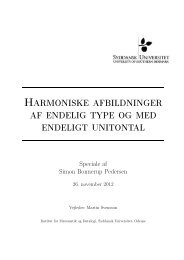A high-resolution version for printing - CP3-Origins
A high-resolution version for printing - CP3-Origins
A high-resolution version for printing - CP3-Origins
You also want an ePaper? Increase the reach of your titles
YUMPU automatically turns print PDFs into web optimized ePapers that Google loves.
[iTIMP: isotriplet Technicolor Interacting Massive Particle as Dark Matter.<br />
Mads T. Frandsen, (Ox<strong>for</strong>d U., Theor. Phys.) , Francesco Sannino, (Southern Denmark U., <strong>CP3</strong>-<strong>Origins</strong>) .<br />
<strong>CP3</strong>-ORIGINS:2009-19, Nov 2009. 4pp. e-Print: arXiv:0911.1570 [hep-ph], Submitted <strong>for</strong> Publication]<br />
Superweakly interacting dark matter<br />
We studied a superweakly interacting dark matter particle motivated by minimal walking technicolor<br />
theories. Our WIMP is a mixture of a sterile state and a state with the charges of a standard<br />
model fourth family neutrino. We showed that the model can give the right amount of<br />
dark matter over a range of the WIMP mass and mixing angle. We computed bounds on the<br />
model parameters from the current accelerator data including the oblique corrections to the precision<br />
electroweak parameters, as well as from cryogenic experiments, Super-Kamiokande and<br />
from the IceCube experiment. We showed that consistent dark matter solutions exist which satisfy<br />
all current constraints. However, almost the entire parameter range of the model lies within<br />
the combined reach of the next generation experiments.<br />
[Superweakly interacting dark matter from the Minimal Walking Technicolor.<br />
Kimmo Kainulainen, Kimmo Tuominen, Jussi Virkajarvi, . <strong>CP3</strong>-ORIGINS-2009-26, Dec 2009. 29pp.<br />
Published in JCAP 1002:029,2010. e-Print: arXiv:0912.2295 [astro-ph.CO]]<br />
Gravitational Waves<br />
We investigated the production and possible detection of gravitational waves stemming from<br />
the electroweak phase transition in the early universe in models of minimal walking technicolor.<br />
In particular we discussed the two possible scenarios in which one has only one electroweak<br />
phase transition and the case in which the technicolor dynamics allows <strong>for</strong> multiple phase<br />
transitions.<br />
[Gravitational Techniwaves. Matti Jarvinen, (Southern Denmark U., <strong>CP3</strong>-<strong>Origins</strong>) , Chris Kouvaris, (Brussels<br />
U.) , Francesco Sannino, (Southern Denmark U., <strong>CP3</strong>-<strong>Origins</strong>) . <strong>CP3</strong>-ORIGINS-2009-24, Nov 2009.<br />
29pp. e-Print: arXiv:0911.4096 [hep-ph], Physical Review D, in press.]<br />
In the near future we plan to:<br />
• Construct new benchmarks <strong>for</strong> models of dynamical electroweak symmetry breaking passing<br />
precision measurements.<br />
• Implement the respective low-energy effective theories in computer programmes able to provide<br />
the relevant physical processes <strong>for</strong> LHC searches.<br />
• Investigate the cosmological consequences of dynamical electroweak symmetry breaking<br />
from dark matter to baryogenesis.<br />
• Study various extensions featuring dynamical electroweak symmetry breaking and their consequences<br />
<strong>for</strong> flavour physics.<br />
• Compare dynamical electroweak symmetry breaking with physical results from LHC when<br />
available.<br />
CP³-Black book 13








